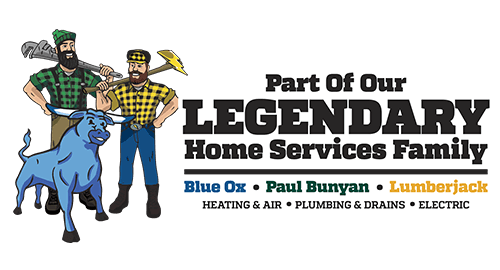Properly running sewers are usually some of the last things on a homeowner’s mind – that is until there’s a need for sewer repair or replacement. For many people, the sewer is out of sight, out of mind, until there’s an emergency. However, a little education about the nature of sewer repairs can help you when you have the need for either a routine or emergency repair.
In fact, even when sewer pipe damage isn’t a true emergency, it can make living in your house smelly and unpleasant. Having an assessment on a regular basis can help you catch issues when they’re little.
Signs Your Sewer Isn’t Working
There can be several signs that you have sewer issues or broken pipes. If you notice any of these signs, or a combination of them in your St. Paul, MN home, then give Paul Bunyan Plumbing & Drains a call. We’ll walk you through diagnosing some of the sings of damaged pipes or sewer system, such as:
- Foul odors from more than one drain. Clogged drains will often give off unpleasant smells, but sewer pipe issues typically cause nasty smells from more than one drain in your home. You may also hear a gurgling sound, which is sewage gas bubbling up through the P-Trap (the curved section beneath the drain) part of the drainpipe.
- Misfires in the plumbing system. For example, if you flush the toilet, does water come up through the drain in the sink, shower, or tub? This is a pretty clear indicator of improper drainage and it’s likely coming from the sewer line.
- Moist basement drains and stinky water pools. If your basement is typically dry, but you suddenly start noticing water droplets around the drains down there, you’re looking at one of the most obvious signs of sewer damage. The basement is the first place in the house that shows signs of damaged sewer pipes.
- Bright green patches on your lawn. While everyone likes green grass, if you have sewage leaks in buried pipes, it fertilizes the grass. For many homeowners with septic tanks, you may notice a brighter spot around where the tank is located.
- Multiple clogged drains in your house. A single clogged drain typically has its own individual cause, whether it’s too much hair in the bathroom, waste in the toilet, or food, coffee grounds, and cooking grease in the kitchen. However, if you suddenly have multiple clogged drains all at once, especially starting with the lower drains in the house and working up, then it’s a sign you need emergency sewer repair.
What Is Trenchless Sewer Repair?
If you’ve been looking for an emergency plumber or sewer repair service online, you’ve probably run across many mentions of trenchless sewer repair. And, if you’re like many homeowners in, you probably aren’t familiar with the ins and outs of fixing your pipes and drains. Choosing the right service and avoiding invasive destruction to fix a pipe is important.
Trenchless sewer repair is a minimally-invasive plumbing technique that repairs damaged sewer pieces without the need for major excavation work on your house, lawn, driveway, or swimming pool.
It’s actually a fairly established technique – trenchless sewer repair has been around since the 1940s, using a slip lining method. With the introduction of structural pipe lining in the 1970s, however, trenchless sewer repair really took off. It’s a type of technique that was first introduced in Europe but is not increasingly popular with homeowners in the US.
This type of plumbing repair involves fixing damage to pipes and the sewer system without the need to dig a trench. Or, it can mean completing underground construction work without extensive digging in your lawn, protecting your landscaping, garden, or pool.
That’s right – some sewer repairs may necessitate digging a trench right through your living room or kitchen! One of the main benefits of trenchless sewer repairs is that Paul Bunyan techs can do the initial inspection and a lot of the repair work without re-routing traffic or digging. These methods are also faster than conventional sewage fixes and can be completed in hours, rather than several days.
How Is Trenchless Sewer Repair Conducted?
There are actually four types of trenchless sewer repair, and each one is intended to work differently, either as the best method for the job or as your plumbing contractor’s preferred technique. These are:
- Structural Pipe Lining, AKA Cured-In-Place Pipe Lining involves inserting a new pipe inside the old one. An epoxy-soaked liner is inserted into the damaged pipe and is left to dry and cure for several hours. When the liner is removed, the epoxy has sealed your sewer pipe as good as new.
- Brush Coating and Spray Lining is similar to the cured-in-place technique. The difference between these is that instead of using the epoxy soaked felt liner that cured-in-place does to create a new pipe inside the old one, brush coating involves a flexible polymer (epoxy) sprayed or brushed onto the inside of the damaged pipe.
- Pipe Bursting replaces a damaged pipe by using a winch with an attached bursting head to place a brand new pipe crafted from HDPE into the old sewer pipe. The old pipe is broken, and the pieces removed, and the new pipe takes its place.
- Slip Lining is the oldest trenchless sewer repair technique, dating from the 1940s. This involves placing a narrower pipe inside the damaged one and filling the area in between the two with grout. It’s more invasive than the other three techniques but still considered trenchless because the insertion pit needed to conduct the repair has to be larger in order to place the replacement pipe sections.
Traditional vs trenchless sewer repair methods
Traditional sewer repairs are invasive and involve heavy-duty excavation equipment, large, long ditches, piles of dirt everywhere, and re-routing pipe traffic. That’s just to start. Once the replacement is complete, then the plumbing company replaces the dirt and any parts of the house that needed to be removed for the trenches. However, your landscaping may take a lot of the brunt of repairs. Conventional preparations and clean-up, plus the actual sewer repair itself, takes a considerable amount of time longer.
While trenchless sewer repair is popular with many homeowners, this isn’t to say that traditional sewer repair isn’t effective. It’s a tried-and-true method. Before you book your plumbing services, however, it’s important to understand the advantages and disadvantages of both methods of fixing your pipes.
Pros of Trenchless Sewer Repair
The advantages of trenchless repair are numerous. Consider these as you’re talking to a reputable plumbing repair company.
- Trenchless repair is faster than traditional methods. Often, the job can be completed in one day, while the same repair would have taken several days – or even weeks for more serious ones – using traditional methods.
- Trenchless repair is more cost-effective than traditional repairs are. While the technology of trenchless methods is individually more expensive than conventional methods, these conventional methods a more expensive, which adds to the overall expense for the job. Not every bid from a plumbing company includes putting your home and landscaping back together again. You may be fortunate enough to have your homeowner’s insurance cover it, but many times, St. Paul homeowners are stuck with a big bill. Depending on what all is done, this can run into the thousands.
- Sewer pipes are located underground and fixing them can be disruptive. Many trenchless fixes are less invasive than conventional methods and reduce the amount of property destruction.
- Trenchless replacement methods tend to keep your property more or less intact, including reducing the need to remove the flooring in your home to excavate beneath it. In fact, traditional methods often include tearing down walls and digging up basement flooring. On the other hand, a trenchless repair can often be conducted by digging just a couple of small holes to access part of the pipe.
- Trenchless techniques are just as effective as traditional ones, in cases where either method may be used. However, these types of methods aren’t always used because they aren’t always the best way to correct the problem.
- Long-lasting – trenchless sewer repairs are designed to last a long, long time. These aren’t quick fixes; in fact, the HDPE pipes used in some techniques have a lifespan of 50 to 100 years.
Cons of Trenchless Sewer Repair
Less invasive repair is often the preferred method for finance-aware clients just like you. However, it’s not always the best fix, and your plumbing contractor can evaluate the damage to your pipes and tell you for sure. There are a few disadvantages to trenchless sewer repair. These include:
- The overall condition of the damaged pipe. If one or more pipes are back pitched, collapsed, or if there are improperly graded trenches, then the trenchless types of repair methods won’t work.
- In other cases, the trenchless repair techniques may not be as cost-effective as the traditional ones. For example, if the damaged pipe is shallowly buried and easy to access, then the trenchless methods can work, but traditional ones may be cheaper in the long run. Most trenchless techniques are often cheaper if the damaged pipe is under the home’s driveway or under the basement or slab of the house. Using traditional methods in these cases will cause thousands of dollars to the house.
How do I know for sure which fix will cost me less?
Knowing for sure whether to book one of the innovative types of sewer pipe repair or to go with a more traditional method is to get off the internet and get in contact with Paul Bunyan Plumbing of St Paul. Our expert technicians can evaluate the problem and prepare two different scenarios for you to evaluate and if you’re able, present to your insurance company.
Our contractors are highly trained to complete a video inspection of the pipes in your house and analyze the damage to these and your drains. Trust a highly respected, experienced professional to complete these, a company with experience completing both conventional and trenchless types of sewer repair.
How Much Does Trenchless Repair Cost in St. Paul, MN?
While trenchless sewer repair is often more cost-effective than traditional fixes, each job is different. Some St. Paul, MN, homes may just have one burst pipe in the yard, a fairly quick fix, while other houses may have more extensive damage. Older homes are constructed with different materials than newer ones, too, and the proper repairs will vary according to the age of the house and how it’s made.
The plumbing company will give you an itemized, custom assessment of the damage and recommendations for correcting it. This may also include some preventative measures for pipes that are worn but not completely damaged yet, to reduce the chances that you’ll have a sewer emergency.
However, as a general rule of thumb, trenchless types of methods cost between $135 and $200 per linear foot. Traditional methods average between $175 and $250 per linear foot. That’s just for the pipes themselves. The costs of replacing grass and landscaping, swimming pool damage, re-paving portions of the driveway, fixing tiles, replacing floors, and re-structuring walls and hanging drywall can add up fast.
Because trenchless sewer repair doesn’t destroy your property as much as traditional methods, the total bid will often be considerably lower. Conventional sewer repairs can often run as high as $25,000!
Contact Paul Bunyan Plumbing & Drains of St. Paul, MN for Trenchless Sewer Repair Today!
If you notice damp spots in your yard or foul odors, then you’ll need to have your sewer fixed, fast. For a better option to traditional sewer fixes, choose Paul Bunyan Plumbing & Drains, professionally certified trenchless sewer repair experts to get you flowing again, FAST! Give us a call or visit us online for a no-obligation quote today!


